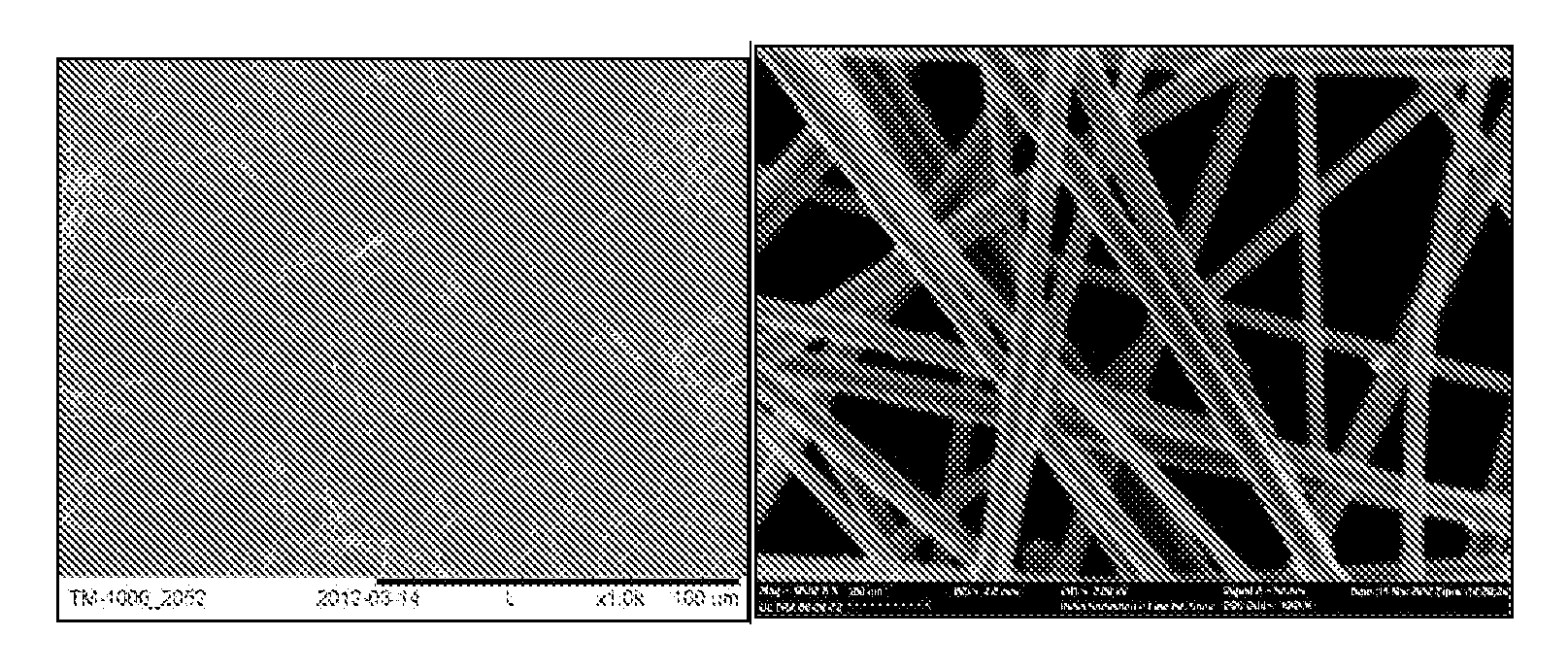Methods of rapid preparation of silver nanowires with high aspect ratio
a technology of aspect ratio and silver nanowire, which is applied in the direction of polycrystalline material growth, crystal growth process, transportation and packaging, etc., can solve the problems of complex reaction conditions, time-comsuming drawbacks, and complex processes, and achieve high manufacturing efficiency, high aspect ratio, and high purity
- Summary
- Abstract
- Description
- Claims
- Application Information
AI Technical Summary
Benefits of technology
Problems solved by technology
Method used
Image
Examples
example 1
[0122]The following solutions were prepared using said chemicals:[0123]0.14 g HCl (0.0038 mol) solution in 100 ml EG (the ‘HCl Solution’)[0124]0.1 g HNO3 (0.0016 mol) solution in 2 ml EG (the ‘HNO3 Solution’)[0125]2.55 g AgNO3 (0.015 mol) in 100 ml EG (the ‘AgNO3 Solution’—made up to be homogeneous at least 30 min before adding to the reaction)[0126]2.55 g PVP (0.0225) (55,000 MW) in 70 ml EG (the ‘PVP Solution’)
Procedure:
[0127]To a 100 mL glassy beaker, was added the PVP solution, 0.7 mL of the HCl solution, 1.5 ml HNO3 solution, 10 ml AgNO3 solution. The mixture was then vigorous stirred for homogeneity. The reaction mixture was then transferred to a microwave oven and then treated with microwave irradiation using 320 W within 5 min. The silver nanowires solution was thus obtained and the reaction was permitted to cool to room temperature. The silver nanowires solution was poured into 250 mL of ethanol. Centrifugalization is used to remove unnecessary solvent and PVP. FIGS. 1A and...
example 2
[0128]The following solutions were prepared using said chemicals:[0129]1.2 g NaCl (0.02 mol) in 100 ml Glycerol (the ‘NaCl Solution’)[0130]1 g HNO3 0.016 mol) solution in 20 ml Glycerol (the ‘HNO3 Solution’)[0131]0.34 g AgNO3 (0.002 mol) in 10 ml Glycerol (the ‘AgNO3 Solution’—made up to be homogeneous at least 30 min before adding to the reaction)[0132]3 g PVP (0.027 mol) (13,0000 MW) in 20 mL Glycerol (the ‘PVP Solution’)
Procedure:
[0133]To a 50 ml glassy beaker, was added the PVP solution, 5 mL of the NaCl solution, 1 ml HNO3 solution, 10 ml AgNO3 solution. The mixture was then vigorous stirred for homogeneity at 25° C. The reaction mixture was then transferred to a microwave oven and then treated with microwave irradiation using 400 W. The irradiation is keeping on until the temperature of the reaction mixture gets to 150° C., and then the temperature of the reaction mixture is maintained for another 1 hours by moving the reaction mixture to a oven settled at 150° C. The silver n...
example 3
[0134]The following solutions were prepared using said chemicals:[0135]0.25 g (0.002 mol) MnCl2 in 100 ml ethylene glycol (the ‘MnCl2 Solution’)[0136]0.3 g HNO3 (0.0048 mol) solution in 100 ml Glycerol (the ‘HNO3 Solution’)[0137]2.5 g AgNO3 (0.0147 mol) in 100 ml ethylene glycol (the ‘AgNO3 Solution’—made up to be homogeneous at least 30 min before adding to the reaction)[0138]5 g PVP (13,0000 MW) (0.045 mol) and 5 g PVP (55,000 MW) (0.045 mol)in 200 ml Glycerol (the ‘PVP Solution’)
Procedure:
[0139]To a 500 ml glassy beaker, was added the PVP solution, 20 mL of the MnCl2 solution, 50 ml HNO3 solution, 100 ml AgNO3 solution. The mixture was then vigorous stirred for homogeneity at 25° C. The reaction mixture was then transferred to a microwave oven and then treated with microwave irradiation using 1200 W. The irradiation is keeping on until the temperature of the reaction mixture gets to 140° C., and then the temperature of the reaction mixture is maintained for another 3 hours by mov...
PUM
| Property | Measurement | Unit |
|---|---|---|
| temperature | aaaaa | aaaaa |
| temperature | aaaaa | aaaaa |
| aspect ratio | aaaaa | aaaaa |
Abstract
Description
Claims
Application Information
 Login to View More
Login to View More - R&D
- Intellectual Property
- Life Sciences
- Materials
- Tech Scout
- Unparalleled Data Quality
- Higher Quality Content
- 60% Fewer Hallucinations
Browse by: Latest US Patents, China's latest patents, Technical Efficacy Thesaurus, Application Domain, Technology Topic, Popular Technical Reports.
© 2025 PatSnap. All rights reserved.Legal|Privacy policy|Modern Slavery Act Transparency Statement|Sitemap|About US| Contact US: help@patsnap.com



